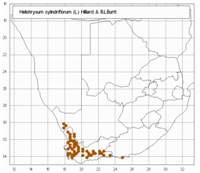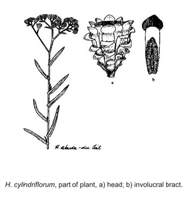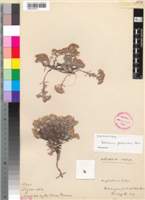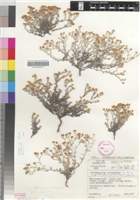Origin of name:
cylindricus /-a/-um = cylindrical (cylindro (Greek), cyllindri (Latin) = roller)flori = flower
Diagnostic characters:
Brown outer bracts; inner bracts white or bright yellow-tipped and tips spreadingSmall to medium-sized heads, solitary or in open groupings
Description:
Bushy half-shrub c. 50-300 mm high, woody at the base and much branched there, branches intricate or more lax, erect or spreading, young parts thinly grey-woolly, leafy, often with dwarf axillary shoots. Leaves mostly 5-30 (-40) x 1-5 mm, diminishing slightly upwards, lanceolate, oblong-lanceolate or subspathulate, apex acute to obtuse, apiculate, base broad, half-clasping, often subauriculate, margins flat or undulate, both surfaces thinly greyish-white woolly, glandular, sometimes glabrescent with age. Heads heterogamous, rarely homogamous, cylindric-campanulate, c. 4-5 x 2.5-3 mm, few clustered at the tips of the branchlets, these in turn corymbose-paniculately arranged. Involucral bracts in c. 7 series, graded, loosely imbricate, outer membranous, backs woolly, tips glabrous, acute, golden-brown or rufous, squarrose, inner with tips slightly exceeding the flowers, these somewhat concave, acute to obtuse, mostly opaque (see notes below), white, creamy or yellow, very rarely pinkish, minutely radiating. Receptacle nearly smooth to shortly honeycombed. Flowers (10-)16-33, (0-)1-4 female, 13-30 homogamous. Achenes not seen, ovaries usually with myxogenic duplex hairs, sometimes glabrous, very rarely female hairy, homogamous glabrous. Pappus bristles many, equaling corolla, scabrid, bases not cohering.
Flowers between September and December.
Distribution:
Common on mountain and hill slopes, on flats, in rocky or sandy places. Widespread in the southwestern districts from Vanrhynsdorp and Calvinia to the Langekloof near Uniondale, with an outlier on the Kamiesberg, from c. 30-1 350 m above sea level.
Fynbos and Succulent Karoo Biomes.
Notes:
H. cylindriflorum is very variable in stature and in degree of branching, dense twiggy little rounded bushes grading imperceptibly to taller, more sparingly branched and more open plants in which the leaves are often larger, particularly longer, than in the more dwarf forms. Characteristically, the small cylindric-campanulate heads are clustered at the branch tips and have involucral bracts with oblong shafts loosely webbed together with wool, the tips of the outer 4-5 series membranous, warm shades of brown and squarrose, the tips of the inner series opaque or subopaque, somewhat concave, radiating, white, creamy or yellow. These inner tips are mostly less than 1 mm long; very rarely do they approach 2 mm. Specimens with bright yellow bracts were distinguished as H. leipoldtii, and appear to predominate in parts of the range, for example in the Hex River Mountains, the Witteberg, and around Touws River, but in the Cedarberg, and in Vanrhynsdorp and Clanwilliam districts, both yellow and creamy bracts are common, while elsewhere pale bracts predominate.
One extreme of the variation range, designated H. fastigiatum by Harvey, is a dense twiggy dwarf bush in which the heads are aggregated as in typical H. cylindriflorum but all the bracts are brown, subpellucid, the tips somewhat concave and slightly crisped. The other extreme is a bush reaching 600 mm in height, also richly branched and tangled, but the heads are borne singly at the tips of leafy stalks (e.g. Acocks 17438, PRE; Esterhuysen 17719a, BOL; NBG; PRE).
The same range, from dwarf compact bushes to tall ones, with heads usually on long stalks, or sometimes with shorter stalks and the heads therefore more closely aggregated, is found in specimens with acute, opaque tips ranging in colour from white through cream to yellow.
Yet another variant has heads on very long stalks and semi-opaque bract tips ranging from buff to yellowish, but the leaves are remarkably glandular-setose. However, glandular hairs are usually present on the leaves of all specimens, hidden under the wool.
Too broad a species concept may have been adopted, but no more can be done in the herbarium.
Taxonomy:
Literature:
Helichrysum cylindriflorum (L.) Hilliard & Burtt in Bot. J. Linn. Soc. 82: 261 (1981).
Type:
Lectotype: Herbarium Plukenet (Herbarium Sloane vol. 100 folio 104, BM).
Synonym(s):
Gnaphalium cylindriflorum L., Pl. Rar. Afr. 19 (1760), Amoen. Acad. 6: 99 (1763), edn 2,6: 58 (1789). G. cylindricum L., Sp. Pl. edn 2: 1194 (1763), nom. illegit. Helichrysum cylindricum D. Don. in Sweet, Hort. Brit. 223 (1826); Less., Syn. Comp. 281 (1832); DC., Prodr. 6: 190 (1838); Harv. in F.C. 3: 220 (1865); Moeser in Bot. Jb. 44: 293 (1910); Levyns in Adamson & Salter, Fl. Cape Penins. 781 (1950).
Gnaphalium aethiopicum minus ramosum capitulis coccineis Plukenet, Almagestum Bot. t. 298, fig. 4 (1694), p. 172 (1696). Note: The figure is wrongly quoted in the text as t. 198 fig. 4 and by Linnaeus as 293 fig. 4.
G. sessile Burm. f., Prodr. Fl. Cap. 25 (1768); Burm., Rar. Afr. Pl. t. 80 fig. 3 (1739). Type: specimen in herbarium Burm. (G).
G. conyzoides Thunb., Prodr. 149 (1800), nom. illegit.
G. rubellum Thunb., Prodr. 150 (1800), Fl. Cap. 653 (1823). Helichrysum rubellum (Thunb.) Less., Syn., Comp. 280 (1832); DC., Prodr. 6: 191 (1838); Harv. in F.C. 3: 220 (1865), incl. vars. Type: Cape, Hex River Mountains, Thunberg (sheet 19247, UPS).
G. paniculatum Thunb., Fl. Cap. 647 (1823), non Berg. (1767). Type: Cape of Good Hope, Thunberg (sheet 19225, UPS).
Helichrysum imbricatum sensu DC., Prodr. 6: 191 (1838), incl. vars, non (L.) Less.
H. fastigiatum Harv. in F.C. 3: 219 (1865). Lectotype: Cape, near Rivier Zonder Einde and Buffeljagd River, Zeyher 2859 (TCD; BOL; K; PRE; S, isolecto.).
H. leipoldtii H. Bol. in Trans. S. Afr. phil. Soc. 18: 382 (1907). Type: Cape, common in sandy fields around Clanwilliam, c. 120 m, also on Ram's Kop near Clanwilliam, Leipoldt 510 (BOL, holo.; K; NBG; SAM, iso.).
H. leipoldtii var. parvifolia H. Bol., l.c. Type: Cape, Clanwilliam, Wuppertal, in rocky places, Bolus 9022 (BOL, holo.).
Vouchers:
Acocks 23681 (PRE); Compton 16775 (NBG); Galpin 4141 (PRE); Schlechter 9050 (PRE); Esterhuysen 18101 (BOL; PRE); Pillans 8592 (BOL; PRE); Pillans 7349 (BOL); Esterhuysen 1668 (BOL; K; PRE; SAM); Esterhuysen 14859 (BOL); Esterhuysen 12070 (BOL).



